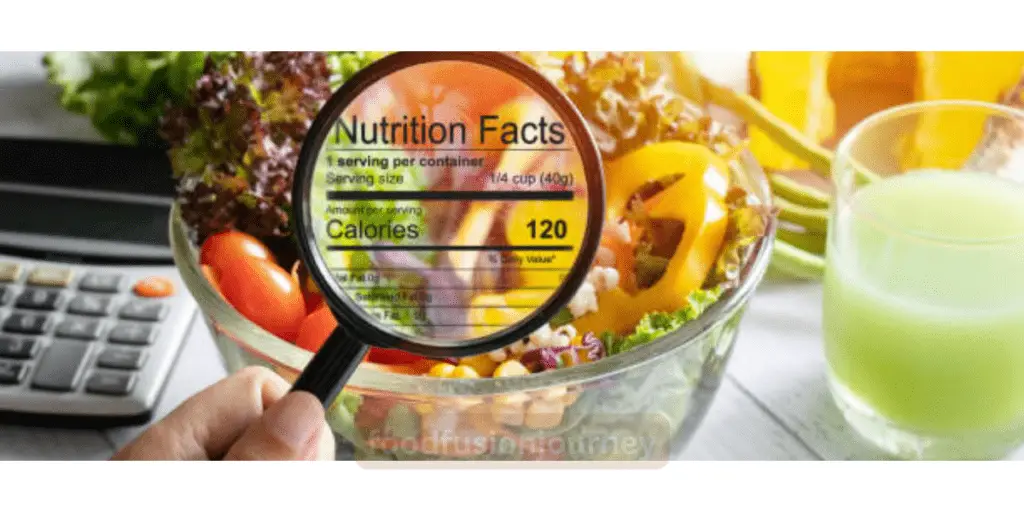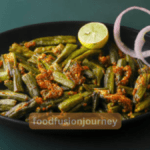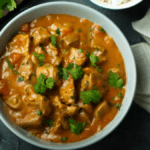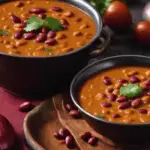Discover the delightful Masala Dosa recipe! Learn how to make crispy dosas filled with a flavorful potato masala filling. This step-by-step guide includes instructions for the dosa batter, coconut chutney, and aromatic sambar. An authentic South Indian dish that will elevate your culinary skills and impress your taste buds. Try it our Masala Dosa now!
Ingredients
For the Dosa Batter
- 1 cup parboiled rice
- 1/2 cup urad dal (split black gram)
- 1/4 cup chana dal (split chickpeas)
- 1/2 teaspoon fenugreek seeds
- Water (for soaking and grinding)
- Salt to taste
For the potato masala filling
- 3-4 medium-sized potatoes, boiled and mashed
- 1 medium sized onion finely chopped
- 1-2 green chilies, finely chopped
- 1/2 teaspoon mustard seeds
- 1/2 teaspoon cumin seeds
- A pinch of asafoetida “hing”
- A few curry leaves
- 1/2 teaspoon turmeric powder
- Salt to taste
- 1-2 tablespoons oil
- 1 tablespoon chopped coriander leaves optional for garnish
For the coconut chutney
- 1 cup grated coconut
- 2-3 green chilies
- 1/2 cup roasted chana dal (dalia)
- A small piece of ginger
- Salt to taste
- Water (for grinding)
For the sambar
- 1/2 cup toor dal (split pigeon peas)
- 1 small onion, chopped
- 1 medium-sized tomato, chopped
- 1 small carrot, diced
- 1 small potato, diced
- A handful of chopped green beans
- 1-2 green chilies, slit
- 1/4 teaspoon turmeric powder
- 1/2 teaspoon mustard seeds
- 1/2 teaspoon cumin seeds
- A pinch of asafoetida (hing)
- A few curry leaves for Masala Dosa
- 1 tablespoon tamarind paste
- 1 tablespoon sambar powder store bought or homemade
- Salt to taste
- 1-2 tablespoons oil
- Water (for cooking dal and vegetables)
Instructions
Dosa Batter Preparation
- Wash the parboiled rice, regular rice, urad dal, and chana dal thoroughly.
- Soak them along with fenugreek seeds in water for at least 4-6 hours or overnight.
- Drain the water and grind the soaked ingredients into a smooth batter using a wet grinder or a high-power blender. Add water as needed to achieve the right consistency.
- Add salt to the batter and mix well, keep the batter to ferment for about 8-10 hours or until it doubles in volume. Keep it in a warm place for better fermentation.
- Potato masala filling preparation:
- Heat oil in a pan and add mustard seeds. Let them splutter.
- Add cumin seeds, asafoetida, and curry leaves. Stir for a few seconds.
- Add chopped onions and green chilies. Sauté until the onions turn translucent.
- Add turmeric powder and mix well.
- Add the mashed potatoes and salt. Mix everything together and cook couple of minutes.
- Garnish with chopped coriander leaves (optional) and set the masala filling aside.
Coconut Chutney Preparation
In a blender, combine grated coconut, green chilies, roasted chana dal, ginger, and salt.
Add some water and blend until you get a smooth chutney consistency. Adjust water as needed.
Sambar preparation for Masala Dosa
- Cook the toor dal in a pressure cooker with enough water until it becomes soft and mushy.
- In a separate pot, add the chopped vegetables, slit green chilies, turmeric powder, and some water. Cook until the vegetables are tender.
- In another pan, heat oil and add mustard seeds. Let them splutter.
- Add cumin seeds, asafoetida, and curry leaves. Stir for a few seconds.
- Add chopped onions and sauté until they become translucent.
- Add the chopped tomatoes and cook until they turn soft.
- To this mixture, add the cooked dal and vegetables. Stir well.
- Add tamarind paste, sambar powder, and salt. Mix everything and let the sambar simmer for a few minutes until the flavors blend together.
Making the Masala Dosa
- Heat a non-stick dosa pan or a griddle over medium heat.
- Pour a ladleful of the dosa batter onto the hot pan and spread it in a circular motion to form a thin dosa.
- Drizzle some oil or ghee around the edges of the dosa.
- Once the dosa turns golden brown and crispy, place a portion of the potato masala filling on one side of the dosa.
- Fold the dosa over the filling, creating a semi-circle or roll as per your preference.
- Serve the masala dosa hot with coconut chutney and sambar.
- Enjoy your homemade Masala Dosas with the delicious potato masala filling, coconut chutney, and flavorful sambar! Happy cooking!
Tips and Tricks for Making Masala Dosa

Fermentation: Proper fermentation of the dosa batter is key to getting the right texture and flavor. Allow the batter to ferment for at least 8-10 hours or overnight in a warm place. A well-fermented batter will give you light and crisp dosas.
Consistency of Batter: The dosa batter should have a medium pouring consistency, similar to pancake batter. It should coat the back of a spoon smoothly.
Hot Griddle: Ensure that the griddle (tava) is properly heated before pouring the batter. Sprinkle a few drops of water on it – if the water sizzles and evaporates immediately, the griddle is ready.
Spreading the Batter: Use the back of a ladle to spread the batter in a circular motion, starting from the center and moving outward. This helps in achieving a thin and even dosa.
Greasing the Griddle: Grease the griddle with a few drops of oil or a small amount of butter before pouring the batter. This helps in making the dosa crispy.
Crispiness: For extra crispiness, you can increase the heat slightly while cooking the dosa. This will give you a golden-brown and crunchy texture.
Potato Filling: Ensure that the potato filling is well-seasoned and cooked. Adding a squeeze of lemon juice or a sprinkle of amchur (dry mango powder) to the filling can enhance the flavor.
Even Spread of Filling: When spreading the potato filling on the dosa, ensure that it’s spread evenly to cover the entire surface. This ensures that every bite has a good balance of flavors.
Variations: You can customize the dosa by adding chopped onions, grated cheese, or other vegetables to the filling for additional flavor and texture.
Serve Hot: Masala dosas are best enjoyed when served hot off the griddle. Serve them immediately with coconut chutney and sambar for the authentic experience.
Practice Makes Perfect: Making dosas might take a bit of practice, especially the spreading of the batter and flipping the dosa. Don’t be discouraged if the first few dosas aren’t perfect – you’ll get the hang of it with practice.
Storing Batter: Leftover dosa batter can be stored in the refrigerator for a couple of days. Make sure to bring it to room temperature before making dosas. If the batter is too thick due to refrigeration, you can add a little water to adjust the consistency.
Dosa Ladle: Using a flat-bottomed ladle specifically designed for making Masala dosas can make the spreading process easier and help you achieve uniform thickness.
With these tips and tricks, you’ll be well on your way to making delicious and crispy Masala Dosa at home!
Nutrition Facts Masala Dosa

The nutrition facts for a Masala Dosa can vary slightly depending on the recipe and the size of the dosa. Here’s a general estimate of the nutrition content for a typical Masala Dosa, which includes the dosa itself and the potato filling:
Serving Size: 1 Masala Dosa (approximately 100-150 grams)
Calories
- Calories per serving: Approximately 150-200 calories
Macronutrients
- Protein: Approximately 2-4 grams
- Carbohydrates: Approximately 25-30 grams
- Dietary Fiber: Approximately 2-4 grams
- Sugars: Approximately 1-2 grams
- Fat: Approximately 4-6 grams
- Saturated Fat: Approximately 1-2 grams
Vitamins and Minerals
- Sodium: Approximately 300-400 milligrams (varies based on salt)
- Potassium: Approximately 100-200 milligrams
- Calcium: Approximately 20-40 milligrams
- Iron: Approximately 1-2 milligrams
Please note that these values are approximate and can vary based on the size of the dosa and the specific ingredients used in both the dosa batter and the potato filling. The dosa itself is typically made from fermented rice and urad dal (black gram) batter, which is naturally gluten-free. The potato filling often includes potatoes, onions, and spices.
The nutrition content can also be influenced by the amount of oil or ghee used for cooking the dosa. If you add coconut chutney or sambar as accompaniments, those will contribute additional calories, carbohydrates, and nutrients.
For a more precise assessment of the nutrition facts for a specific Masala Dosa, it’s best to refer to the nutrition label if available or consult a registered dietitian based on the exact ingredients and portion sizes used.






